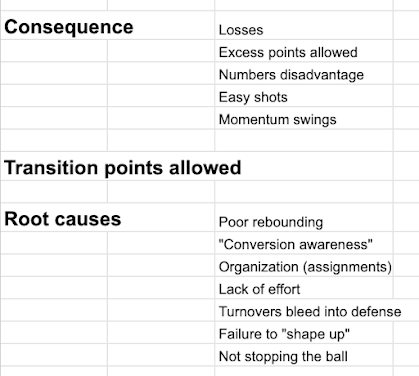Chocolate cookies resemble basketball. They differ in quality. As an aficionado, you notice differences.
Joanne Chang makes the best chocolate cookies at her bakery, Flour. She shares technique at MasterClass. What's her secret and how does that relate to basketball? "One day these cookies will be famous," read her departure memo from consulting.
You want to bake these masterpieces?
1. "Mise en place." Gather all in place. She sets out the cookware and ingredients.
Basketball: Plan, prepare, practice. Set out our philosophy, practice components, and playbook for our players. Explain how each ingredients adds to the whole. Basketball is in the public domain; there are no secrets.
2. Temperature. Have the right temperature. Measure it. Attend to details. Thomas Keller says, "all cooking is about time and temperature." Chang says not to make the cookies unless you KNOW the temperature of your oven (cooking thermometer).
Basketball: We constantly take the temperature of our athletes. Assess their intensity and their mental state. Patience (time) and faith (belief at work) flank the top of Coach Wooden's "Pyramid of Success" for good reason.
3. Kitchen scale. Volume and weight are not alike.
Basketball: Two players have the same physical makeup; they are not the same player. Filling a cup with marbles is different than filling a cup with sand although both are a cup. Recognize differences.
4. Temperature of ingredients. Adding cold eggs to your creamed sugar/butter mix changes the flakiness of the bake. 30 seconds in hot water will bring our eggs to room temperature.
Basketball: If a player is cold, get her involved. Run a set play for her, change the tempo, and emphasize the total game, contributions through defense, rebounding, playmaking.
5. Quality of chocolate. Those semi-sweet chocolates are not the be-all, end-all. Chang uses high grade chunk chocolate and add in a touch of milk chocolate.
Basketball: Better ingredients, better basketball. Assign imaginary grades to your players - lottery pick, first rounder, second rounder, free agent. Skill development can help move players up a grade but lottery picks are few. "Every day is player development day."
6. Mixing matters. Overmixing activates gluten and makes them firmer than our desired consistently. A little pulsing and gently turning the batter works the dough without overworking.
Basketball: Finding the right blend of players is an art. We can overmix the roster and get the wrong consistency. Red Auerbach said, "it's not the five best players but the five players who play best together."
7. Secret ingredients. Baking soda is not baking powder. Unsalted butter is not salted butter. A half teaspoon of vanilla adds to the mix.
Basketball: Special sauce includes caring for each other, mentoring, positivity, and player and ball movement.
8. The binder, "glue guy" matters. Adding some bread flour to all-purpose flour improves the consistency of our cookies.
Basketball: We need the players who bring the mix together. They may not be the most talented or most athletic, but they hold the team together.
9. Rest the dough. Three hours to overnight airtight resting allows the flour to incorporate the wet ingredients better.
Basketball: You can overtrain our athletes. Shakespeare wrote,



























